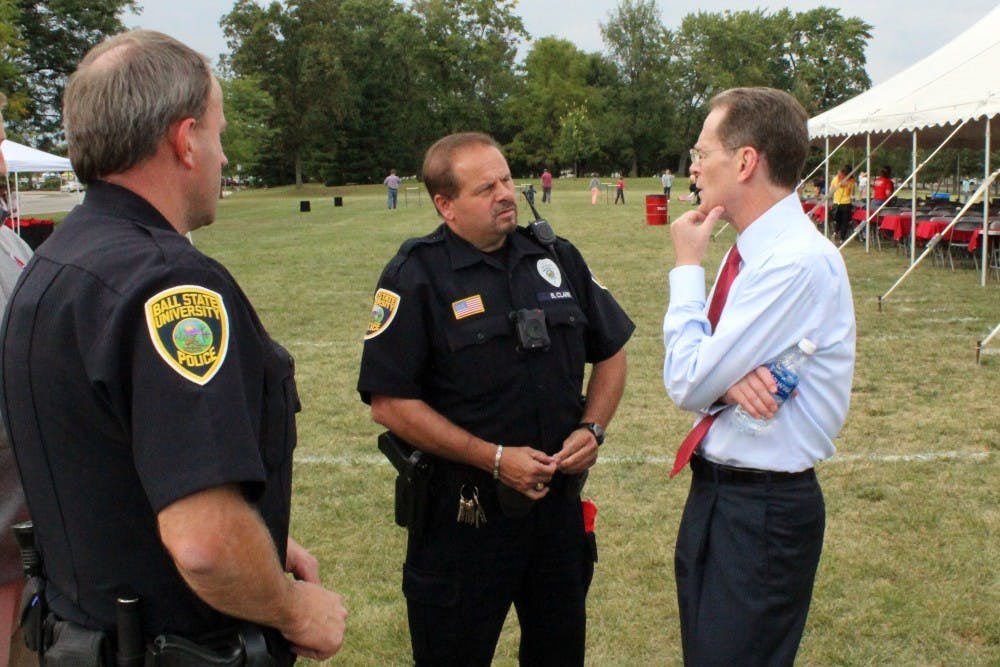Editor's note: In honor of the university's centennial year, The Daily News is counting down 100 days to the university's celebration Sept. 6 with 100 of Ball State's most famous traditions and figures. Check back each day to read about Cardinal history.
The official University Police Department (UPD) wasn’t started until the 1960s, but there has always been a group tasked with watching over Ball State.
When the university was known as Indiana Normal School, a group of unarmed security guards was hired to check and lock buildings around campus and were typically paid 70 cents an hour, according to Ball State’s website.
The Assistant Dean of Students would call the Heat Plant — which was the main hub for traffic through campus — when a watchman was needed. A worker at the plant would then turn on a red light in a specific window of the plant to alert the watchmen.
The department’s first director of traffic safety and security, Thomas Osborn, was hired by then-president John Emens March 12, 1957.
Then, in 1958, the department had grown so much it was moved into a new building with a chief’s office, kitchen, bathroom and radio/office room, where the first police radio was installed to replace the red light system.
While most officers were assigned to foot patrol during that time, the department had a three-wheeled motor scooter, which was primarily used by the officer in charge of fire safety, extinguisher checks and other campus safety issues, Edwin Ritchey, according to Ball State’s website.
After Ball State Teachers College became Ball State University, however, the department was able to get two vehicles.
Eventually, Chief Osborn started the first stage of an ambulance service — a station wagon with an ambulance cot and first aid equipment — in the university community due to the department’s increased transportation of people to the health center and hospital, according to Ball State’s website.
While the Ball Health Center received 90 percent of calls, the officers received the other 10 percent and eventually a full ambulance service was introduced. This service, however, was discontinued upon the founding of Delaware County EMS.
As enrollment at Ball State increased, so did the police force. However, the department’s transition into what it is today didn’t begin until the Indiana legislature passed a statute in July 1971 allowing colleges and universities to create fully-functioning police departments due to civil unrest and war protests.
During Bob Reed’s time as police chief, two horses were purchased to serve on the new horse patrol. The horses were housed in a barn located where the current alumni center is.
The horses were later retired, but they weren’t the last animals the department owned. In the 1990s the first police dogs were purchased and trained for drug detection and patrol use.
It was Gene Burton, who became the department’s fourth chief in 2002, that led the department to be the first accredited college police department in Indiana.
Currently the department is one of two Indiana international accredited campus law enforcement agencies and on Nov. 5, 2016, the Commission on Accreditation for Law Enforcement Inc. (CALEA) recognized Ball State’s police force for the fourth time, according to Ball State’s website.
It wasn’t until March 2007 that the department moved into its current location at 200 N. Mckinley Ave.
Inside the current building is a dispatch center, video surveillance systems, training rooms and more to aid officers. There is also a display case with holsters, hats, sheathes and other items that were donated by past police officers and used by the department itself.
In a previous Daily News article, Capt. Rhonda Clark said the case was designed “to show where law enforcement comes from and where it is now.”
Today, UPD serves the Ball State community through normal policing, educational presentations on active shooter situations and how to protect oneself from domestic violence and rape, a motorist assist program and a residence security survey.
The department also hosts a bike registration program, Charlie’s Charter, dunk-a-cop and lunch with UPD.
Officers are trained to protect the university and its surrounding areas in several ways. During an episode of The Weekly, a Daily News podcast series, Jim Duckham, current police chief and director of public safety, and Lt. David Bell said members of UPD are trained to de-escalate situations, find alternatives for uses of force, know the university’s tunnel system and understand community policing efforts.
Read more centennial content here.
Contact Brooke Kemp with comments at bmkemp@bsu.edu or on Twitter @brookemkemp.





